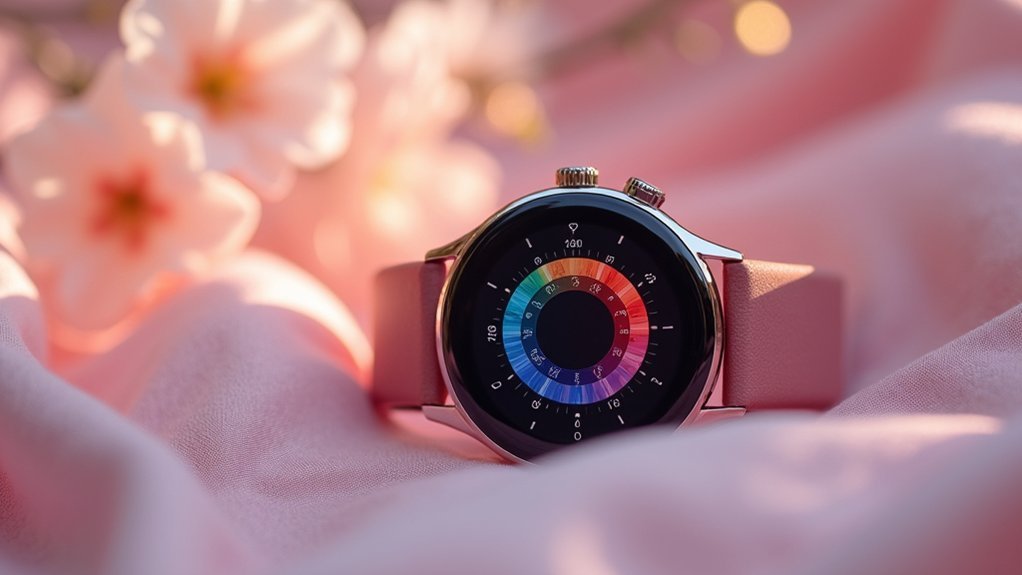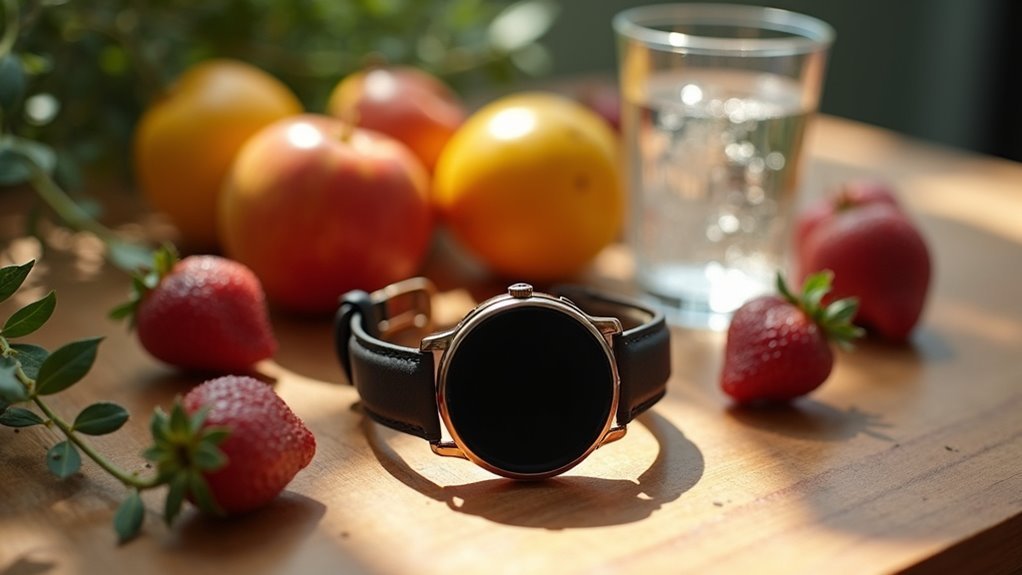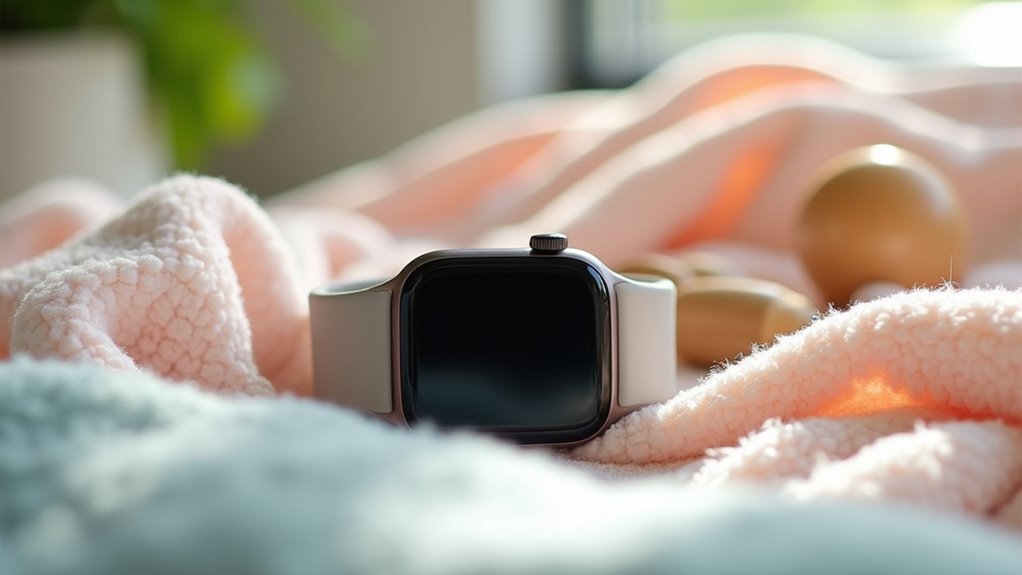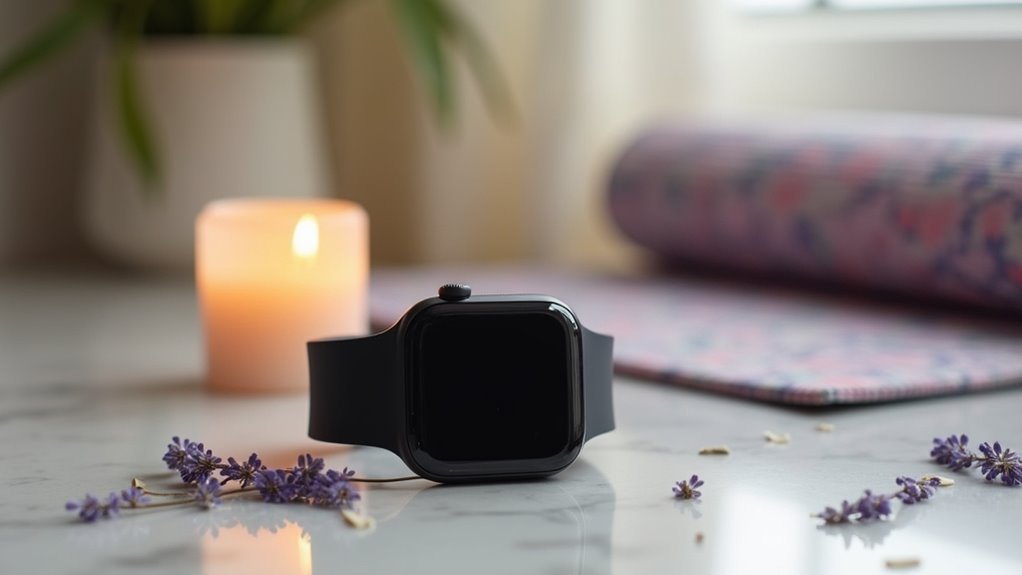You’ll master smartwatch menstrual tracking by setting up continuous monitoring through PPG and temperature sensors that detect hormonal fluctuations automatically. Choose devices like Apple Watch Series 10, Fitbit, or Oura Ring for their advanced women’s health features. Configure cycle logging, symptom tracking, and fertility predictions while adjusting privacy settings to your preferences. The biometric data reveals patterns in heart rate variability and skin temperature changes throughout your cycle phases. This thorough approach transforms your health insights considerably.
Understanding How Smartwatch Menstrual Tracking Technology Works
While traditional period tracking apps rely on manual input and calendar predictions, smartwatches take a fundamentally different approach by continuously monitoring your body’s physiological signals.
Your device uses photoplethysmography (PPG) sensors to track heart rate and heart rate variability, while temperature sensors measure wrist skin temperature throughout your cycle. These sensors detect subtle changes caused by hormonal fluctuations that occur during different menstrual phases.
PPG sensors monitor heart rate changes while temperature sensors track skin fluctuations, detecting hormonal shifts throughout menstrual phases.
Your smartwatch collects data on respiratory rate and skin perfusion to create a thorough physiological profile. Machine learning algorithms analyze this multisensor data to identify patterns and predict your cycle phases with approximately 90% accuracy for fertility windows.
The device performs continuous monitoring, particularly during sleep when external factors won’t interfere with readings, enabling personalized cycle tracking. Advanced algorithms can also flag abnormalities in your cycle patterns that may indicate underlying reproductive health conditions requiring medical attention.
Top Smartwatch Brands and Their Cycle Monitoring Capabilities
As the smartwatch market continues expanding, major brands have developed distinct approaches to menstrual cycle monitoring that cater to different user preferences and needs.
Apple Watch Series 10 leads with advanced sensors and seamless ecosystem integration for thorough fertility tracking.
You’ll find Fitbit models excel in period tracking through their dedicated app, focusing specifically on women’s health needs. Fitbit devices offer the added convenience of synchronizing with any device using their dedicated app for comprehensive health monitoring.
Samsung Galaxy Ring combines menstrual monitoring with broader wellness features, while Oura Ring specializes in deep cycle tracking by syncing with apps like Natural Cycles.
Amazfit watches, though not highlighting specific menstrual features, provide reliable health tracking with exceptional battery life.
Each brand offers unique strengths, from Apple’s technological sophistication to Oura’s comfortable ring design and in-depth monitoring capabilities.
Setting Up and Customizing Your Menstrual Health Features
Setting up menstrual health features on your smartwatch requires accessing the device’s companion app to begin the initialization process. You’ll need to register your cycle details, including start date, period length, and average cycle duration for personalized predictions. Add the tracking widget to your watch’s home screen for quick access.
| Feature | Setup Action | Customization Options |
|---|---|---|
| Cycle Logging | Enter period dates and flow intensity | Add/remove symptoms, mood tracking |
| Notifications | Set reminder frequency and timing | Period alerts, fertility windows |
| Privacy Controls | Configure data sharing permissions | Authentication, app-specific security |
| Symptom Tracking | Log daily health parameters | Temperature, cramps, headaches |
| Fertility Mode | Enable pregnancy/family planning options | Ovulation predictions, fertile days |
The app will display fertile days and ovulation predictions alongside your next period forecast to provide comprehensive reproductive health insights. Link your smartwatch with your smartphone to synchronize data across devices for thorough health monitoring.
Leveraging Biometric Sensors for Accurate Cycle Predictions
Beyond manual data entry and basic reminders, modern smartwatches harness sophisticated biometric sensors to automatically detect and predict your menstrual cycle phases with remarkable precision.
Your device’s heart rate sensors detect significant rises in resting HR during ovulation and luteal phases, while skin temperature sensors measure cyclical shifts corresponding to basal body temperature changes throughout your cycle.
These multi-parameter systems collect nightly physiological data to minimize daily variations and improve accuracy. The Oura Ring achieves a 96.4% ovulation detection rate with just 1.26 days average error, outperforming traditional calendar methods.
AI algorithms process these continuous data streams, adapting to your irregular cycles and providing personalized predictions that improve over time through machine learning capabilities. The Oura Ring can alert users six days before their period starts by monitoring these natural temperature patterns.
Maximizing Health Benefits Through Smart Cycle Data Analysis
While your smartwatch collects continuous physiological data, the real power lies in transforming this information into actionable health insights that extend far beyond fertility tracking.
You’ll discover patterns that reveal how lifestyle changes affect your cycle, helping you identify early warning signs of potential health issues before traditional testing methods.
Your smart cycle analysis enables personalized symptom management by recognizing recurring patterns in mood, energy levels, and physical symptoms.
Smart cycle tracking reveals your body’s unique patterns, enabling targeted management of mood swings, energy dips, and physical symptoms.
You can optimize your health decisions by understanding how sleep, exercise, and stress impact your menstrual patterns.
This data-driven approach transforms your cycle into a crucial sign, providing continuous health monitoring that helps you make informed lifestyle adjustments and communicate more effectively with healthcare providers about concerning changes. Modern smartphone apps like Apple Health make this comprehensive tracking effortless and accessible for daily use.
Frequently Asked Questions
How Secure Is My Menstrual Cycle Data on Smartwatches?
Your menstrual cycle data’s security depends on your smartwatch brand. Garmin offers strong privacy protection, while others may share data with third parties. You’re not protected by HIPAA, so choose devices with robust privacy policies.
Can I Share My Cycle Data With My Doctor?
You can share your cycle data with your doctor by reviewing it during consultations or exporting it from your smartwatch’s health app to facilitate more personalized healthcare discussions and insights.
Do Smartwatch Menstrual Features Work Without a Smartphone Connection?
You can use basic menstrual tracking features on smartwatches without a smartphone connection. However, you’ll need to sync regularly for detailed analysis, data sharing, and advanced insights to work properly.
How Much Does Smartwatch Cycle Tracking Affect Battery Life?
Cycle tracking apps increase your smartwatch’s screen and CPU usage, moderately impacting battery life. You’ll likely need daily charging instead of multi-day use, but power-saving modes help minimize drain.
Are Menstrual Tracking Smartwatches Suitable for Teenagers?
You’ll find menstrual tracking smartwatches quite suitable for teenagers since they’re accurate, help build health literacy, and enable proactive cycle management, though you should consider potential emotional impacts from prediction inaccuracies.





Leave a Reply